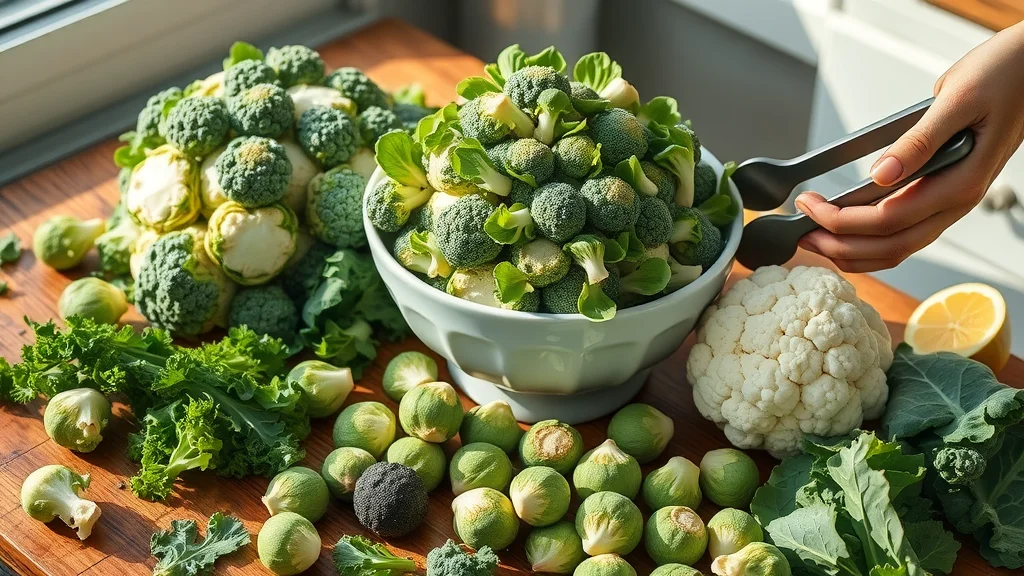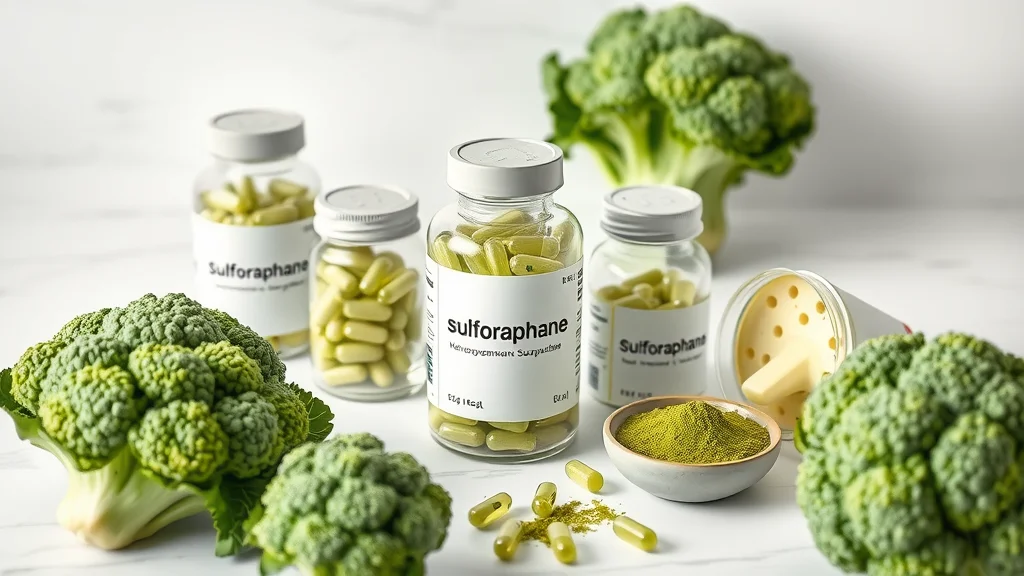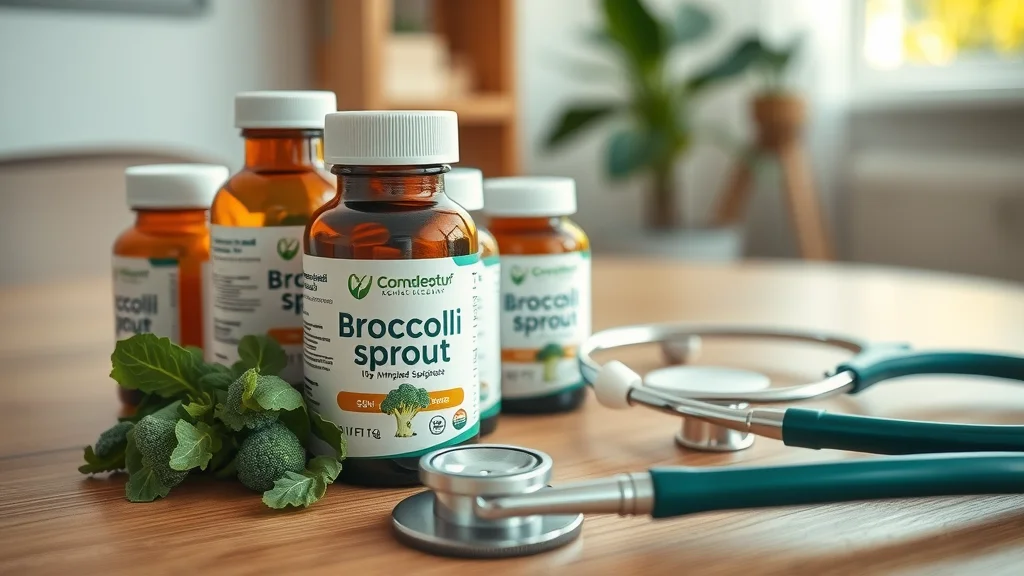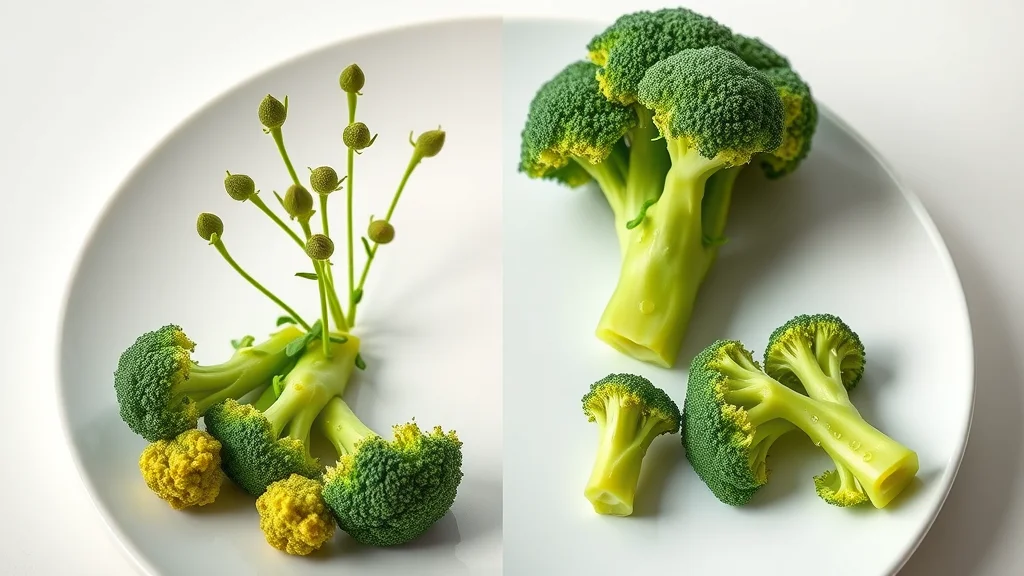Why Sulforaphane Could Be the Health Boost You Need
"Let food be thy medicine and medicine be thy food." – Hippocrates
Imagine unlocking a powerful health boost with every bite of a humble green sprout. Sulforaphane, a natural compound found in cruciferous vegetables like broccoli sprouts, is rapidly gaining popularity among scientists, doctors, and wellness enthusiasts across the United States. Why?
This antioxidant-rich molecule may help your cells defend themselves against stress and inflammation, support detoxification, and even play a role in long-term disease prevention—without complicated routines or pricey pills.
In this guide, you’ll discover why sulforaphane is making waves in nutrition circles. You’ll also get practical tips on how to easily add it to your meals and supplement smartly, all backed by cutting-edge research and expert insights.

Sulforaphane’s Rising Popularity in the United States
Sulforaphane origins in broccoli sprouts
Growing scientific attention on sulforaphane
Why a natural approach is trending
There’s a reason health stores and wellness blogs across the United States are buzzing about sulforaphane. It all starts with broccoli sprouts—tiny greens that pack a huge antioxidant punch. Popularized by nutrition research in the last decade, sulforaphane has seen a surge of interest as people seek more natural, plant-based health strategies rather than relying completely on synthetic supplements.
Scientific studies—like those from Johns Hopkins and cited in trusted gov websites—show sulforaphane’s beneficial effect on everything from reducing oxidative stress in cells to supporting phase II enzyme activity, pivotal for detoxification (Li et al., Zhang et al.). As plant-based eating takes hold and concerns grow over chronic illness, this natural compound’s reputation continues to rise, especially among those seeking to boost daily energy levels and overall wellness with real food.
What You'll Learn About Sulforaphane
The science behind sulforaphane
Sulforaphane’s health benefits supported by research
Sources of sulforaphane in food
How to use sulforaphane supplements safely
Recognizing possible side effects

What Is Sulforaphane? Understanding This Powerful Broccoli Compound
Sulforaphane is a natural plant compound most abundantly found in cruciferous vegetables—especially in broccoli sprouts. It belongs to a group known as isothiocyanates, which are formed from glucoraphanin in the presence of the enzyme myrosinase (released when these vegetables are chopped or chewed). What sets sulforaphane apart is its ability to activate phase II detoxification enzymes and antioxidant responses, offering a multi-layered defense for your body.
Unlike some plant compounds that simply act as antioxidants, sulforaphane triggers your body’s own cellular defense systems—think of it like flipping genetic “on switches” that strengthen resilience against inflammation, toxins, and even cancer cell threats. According to research by Li et al. and Zhang et al., this makes sulforaphane a standout among nutrients derived from the broccoli sprout and cruciferous family, standing head and shoulders above most for its bioavailability and potency.
How Sulforaphane Is Formed in Broccoli Sprouts

When you chew or chop broccoli sprouts, you kick off a chemical reaction: the glucoraphanin stored in the plant tissues meets the enzyme myrosinase, and sulforaphane is the energetic result. This process is most efficient in raw sprouts, which is one reason why researchers and nutrition experts encourage eating them fresh rather than overcooked. The early growth stage of broccoli sprouts provides the highest concentration of glucoraphanin—up to 100 times more than mature broccoli florets (Zhao et al.).
Temperature, storage, and preparation all influence sulforaphane formation. For example, microwaving broccoli sprouts lightly (not boiling) can help preserve enzyme activity, while heavy cooking can destroy the key myrosinase enzyme, drastically reducing the health benefits. If you want maximum impact, consider tossing fresh sprouts into salads or smoothies—an easy, tasty way to make the most of this natural compound.
As you explore the benefits of sulforaphane and other plant-based compounds, it's also important to consider how certain vegetables can impact your health in different ways. For example, some individuals may be sensitive to natural substances like oxalates found in various greens—if you're curious about this topic, you can learn more in our guide on understanding oxalates and their effects in vegetables.
Sulforaphane vs. Other Cruciferous Compounds
The chemistry of sulforaphane
Broccoli sprout bioavailability
While all cruciferous vegetables—think kale, Brussels sprouts, cauliflower—contain beneficial isothiocyanates, sulforaphane is special because of its high potency and absorption in the body. Many similar compounds don’t make it past digestion or reach cellular targets, but sulforaphane boasts excellent bioavailability when consumed as broccoli sprouts or their extract. According to phase II enzyme activation studies, sulforaphane excels at tripling our body’s defense systems compared to other isothiocyanates.
Its unique chemistry is also why broccoli sprout extract supplements have become so popular—delivering the right enzymes and precursors in concentrated, bioavailable form. That said, supplement absorption can vary based on the presence of myrosinase and other cofactors, so understanding your food and supplements is key for optimal health benefits.
The Science Behind Sulforaphane: Mechanisms and Effects
"Sulforaphane is one of the most potent naturally occurring activators of cellular defense mechanisms." – Dr. Jed Fahey, Johns Hopkins University
How Sulforaphane Works in the Body

Once consumed, sulforaphane sets off a biological domino effect. It enters cells and “flips the switch” on key defense mechanisms—most notably the Nrf2 pathway. This genetic pathway controls how your body responds to threats like oxidative stress and toxins, making it central to health maintenance, chronic disease prevention, and even longevity studies.
Scientists, including those cited in recent gov website resources, have documented these key sulforaphane mechanisms:
Activation of Nrf2 pathway: Sulforaphane binds to sensor proteins, which release Nrf2 to upregulate >200 genes responsible for antioxidant and detox effects.
Detoxification enzyme stimulation: Phase II enzymes (including glutathione S-transferase) are boosted, helping clear out cellular toxins and pollutants.
Antioxidant effects: Sulforaphane helps neutralize harmful free radicals, protecting your cells from damage and premature aging.
In the United States, small wellness startups are tapping into this science—launching new functional foods and drinks with broccoli sprout extract to meet growing consumer interest in sustainable, natural health solutions.
Real-world example: Small wellness startups in the United States leveraging broccoli sprouts for new functional foods
Health Benefits of Sulforaphane Backed by Research
Top Sulforaphane Health Benefits
Reduction of inflammation
Support for cardiovascular health
Potential anti-cancer properties
Brain health and neuroprotection
Modern research—featured in scientific journals and official government websites—confirms that the health benefits of sulforaphane are wide-ranging and substantial. Studies like those by Li et al. and Zhao et al. point to sulforaphane’s potential in protecting against cancer cell growth, thanks to its ability to support phase ii enzymes and detox processes.
Additionally, by lowering oxidative stress and inflammation, sulforaphane may reduce the risk of long-term chronic diseases including cardiovascular disease, neurodegeneration (protecting memory and brain function), and even support immune system vitality.
Practical tips? Try adding raw broccoli sprouts to shakes or sandwiches, or opt for supplements standardized to deliver the active compound in every dose, ensuring you get the science-backed advantage at home.
Major Health Benefit |
Key Study |
Practical Tip |
|---|---|---|
Immune Support |
2022 |
Add raw broccoli sprouts to smoothies |
Brain Health |
NeuroJournals 2021 |
Use fresh raw broccoli over cooked |

Expert Insights: Sulforaphane and Modern Wellness
Leading scientists and nutritionists see sulforaphane as a bridge between ancient wisdom (“let food be thy medicine”) and modern evidence-based health. Case in point: studies from the National Institutes of Health and zhao et al. demonstrate real health benefits—like increased antioxidant status and a positive impact on energy level—when broccoli sprouts are included regularly in diets.
Dr. Jed Fahey of Johns Hopkins claims sulforaphane is unique among plant compounds for its ability to activate our body’s own defense response, giving everyday eaters a level of protection usually sought through pharmaceuticals.
In practical terms, sulforaphane-rich foods and supplements are now widely available in wellness clinics, supermarkets, and even local farmer’s markets in the United States. From health coaches to registered dietitians, experts everywhere are recommending small daily servings to help boost resilience, fight inflammation, and foster whole-body vitality.
Sulforaphane in United States Health Trends
"Eating broccoli sprouts daily increased antioxidant status in adults," – National Institutes of Health study
Americans are hungry for simple tools that can support health without complicated regimens or harsh side effects. Sulforaphane fits right in—offering a naturally powerful, research-backed compound with proven health benefits to boost wellness. Today, you’ll spot broccoli sprout extract in specialty drinks, protein shakes, and new microgreen-based superfoods, all shaped by consumer demand for trusted, plant-powered solutions. Whether you follow the latest diet trends or not, incorporating these nutrient-dense greens could be a smart move for your long-term well-being.
According to recent market analysis, supplement sales for sulforaphane products in the United States have grown by 30% year-over-year, reflecting not just a passing trend, but a growing trust in natural food-based health solutions. The fusion of cruciferous vegetables with functional nutrition is expected to grow even more in coming years.
Broccoli Sprouts: The Best Sulforaphane Food Source
Why Broccoli Sprouts Are Sulforaphane Powerhouses
Extremely high sulforaphane concentrations
Quick growth in microgreen gardening
When it comes to natural sources of sulforaphane, broccoli sprouts are in a league of their own. These baby greens pack the highest concentration of glucoraphanin (the sulforaphane precursor) among all cruciferous vegetables, offering up to 50–100 times more sulforaphane than mature broccoli heads. That’s why even small servings make a big impact.
Broccoli sprouts are also quick to grow—perfect for home gardeners or urban dwellers trying microgreens for the first time. In less than a week, you can harvest a powerful, crunchy ingredient ready to elevate smoothies, salads, and wraps. If you’re looking for inspiration, local health shops and niche cafés in the United States are now serving up dishes centered entirely around these nutrient-packed microgreens.

List: Other Foods High in Sulforaphane
Broccoli florets
Kale
Brussels sprouts
Cauliflower
While broccoli sprouts deliver the greatest punch, you can also find sulforaphane (albeit in lower amounts) in other cruciferous vegetables. Including a mix of these foods ensures a range of isothiocyanates and antioxidant nutrients, supporting broad-spectrum wellness.
For busy families or picky eaters, even a handful of raw kale, a few Brussels sprouts, or a generous scoop of roasted cauliflower provides consistent, cumulative benefits. Rotate these greens through your weekly meals—and don’t forget, adding a little mustard seed can enhance the activation of sulforaphane in cooked dishes!
Curious to try growing your own? It’s easier than you think, and homegrown sprouts can become a staple in your plant-forward kitchen.
Sulforaphane Supplement Guide: Benefits and Best Practices
Choosing the Right Sulforaphane Supplement
Extract source: broccoli sprout vs. seed
Potency and standardization
Reputable brands and purity tests
Not everyone enjoys broccoli sprouts daily—that’s where sulforaphane supplements come in. To ensure you’re getting high-quality bioactive compounds, look for products made from broccoli sprout extract rather than mature seed, as sprouts deliver more consistent potency. The best brands provide standardized dosages (listed as milligrams of sulforaphane or glucoraphanin) and include myrosinase or mustard seed for improved absorption.
Always check for third-party purity certifications (like GMP or NSF) and research the company’s reputation—reading reviews or browsing their official website can help you identify trustworthy sources. The United States supplement industry has strict rules for labeling and testing, but not all products are created equal. When in doubt, consult a care provider or registered dietitian before starting any new supplement.

How to Take Sulforaphane Supplements Safely
Check for GMP certifications
Follow recommended dosages
Monitor for any side effects
Consistent, safe supplementation starts with following the manufacturer’s guidelines—and your healthcare provider’s advice. Take only the recommended daily dose; more is not always better. If you experience side effects such as digestive upset, headaches, or any unusual symptoms, stop taking the sulforaphane supplement and consult a healthcare professional. Also, people with thyroid issues or those on specific medications should discuss potential interactions with a qualified doctor or pharmacist.
Here’s a quick supplement comparison:
Brand |
Formulation |
Sulforaphane mg/serving |
Cost |
|---|---|---|---|
"Brand A" |
Capsule |
20mg |
$25 |
"Brand B" |
Powder |
30mg |
$40 |
Side Effects of Sulforaphane: What You Need to Know
Common Sulforaphane Side Effects
Gastrointestinal discomfort
Mild headaches
Changes in thyroid function (rare)

For most people, sulforaphane-rich foods and supplements are safe, well-tolerated, and have minimal side effects. However, as with any concentrated extract or new addition to your daily routine, there can be side effects. The most commonly reported side effects include mild gastrointestinal discomfort (such as bloating), occasional headaches, and—rarely—impacts on thyroid hormone metabolism, particularly with high sulforaphane supplement doses. Studies from zhao et al. and several official websites suggest these effects are usually temporary and subside after adjusting the dosage or pausing use.
Pay attention to your body, start with small doses, and consult your care provider if you notice unusual symptoms. For most, these effects are a minor trade-off for the broader health benefits that sulforaphane can deliver.
Who Should Be Cautious with Sulforaphane Intake
"As with any supplement, consult a healthcare provider when considering sulforaphane supplements—especially for those with thyroid conditions." – Dr. Emily Lee, Registered Dietitian
While eating whole cruciferous vegetables like broccoli and kale is generally safe for everyone, concentrated sulforaphane supplements may not suit people with certain medical conditions. If you have thyroid issues, are pregnant, breastfeeding, or are already taking medication for a chronic illness, talk to your care professional or doctor before starting any new supplement. Individuals with sensitivities to mustard seed or other related plants should also proceed with care due to potential allergenic effects.
Remember: balance, moderation, and professional guidance will keep your wellness journey on the right track.
Frequently Overlooked Considerations for Sulforaphane Supplement Users

Many users overlook the importance of the enzyme myrosinase present in fresh broccoli sprout products—without it, sulforaphane supplement bioavailability and effectiveness can significantly drop. Additionally, multiple supplements may interact with one another, and not all brands source their broccoli sprout extract from high-quality, contaminant-free suppliers. If you’re stacking multiple antioxidants, be aware of overlapping effects, and always cross-check with your doctor—especially if you’re managing other chronic conditions with prescription medication.
Lastly, reputable brands typically provide transparency about their growing, harvesting, and testing methods. Always read labels and consult resources on the official website of your chosen product.
FAQs: Your Sulforaphane Questions Answered
How does sulforaphane benefit the body?
Sulforaphane supports your body in multiple ways: it activates your cells’ protective Nrf2 pathway, reduces inflammation, and helps eliminate toxins through phase II detox enzymes, contributing to its notable health benefits. In both food and supplement form, sulforaphane can contribute to immune strength, better energy levels, improved heart health, and brain protection—making it a versatile compound for everyday resilience.
Are there downsides or side effects to sulforaphane?
The main downsides are mild: some people experience stomach upset, gas, or headaches, especially when starting supplements or eating very large portions of raw cruciferous vegetables. Rarely, high doses of sulforaphane (particularly from supplements, not food) can impact thyroid function. These effects usually resolve quickly after reducing dosage, but always check with your care provider if you’re unsure.
Which foods provide the highest sulforaphane levels?

Broccoli sprouts are the undisputed leaders for natural sulforaphane, delivering up to 100x the content of mature broccoli florets. Other solid sources include kale, Brussels sprouts, and cauliflower, but for maximum benefit, toss a handful of sprouts onto your next sandwich, salad, or bowl!
Can sulforaphane impact thyroid function?
Large doses of sulforaphane—in supplement or extract form—may affect thyroid hormone levels, though this is rare and usually only occurs with chronic, very high intake. Most healthy individuals will not experience thyroid issues from normal dietary portions, but those with existing thyroid disease or risk factors should always consult a doctor before regular use of sulforaphane supplements.
Answers provided below each PAA question.
People Also Ask: Deep Dive
What does sulforaphane do for the body?
Sulforaphane activates protective pathways in cells, promotes detoxification, reduces inflammation, and may support brain and heart health.
What are the downsides of sulforaphane?
Potential downsides include gastrointestinal upset, headaches, and—rarely—effects on thyroid function, especially with excessive use of sulforaphane supplements.
What food has the highest sulforaphane?
Broccoli sprouts have the highest sulforaphane content compared to any other common food.
Does sulforaphane affect the thyroid?
In rare cases, large doses of sulforaphane may impact thyroid hormone function. Most people do not experience this, but consultation with a healthcare provider is recommended if you have thyroid issues.
Key Takeaways: Sulforaphane Simplified
Sulforaphane is a potent, natural health-promoting compound
Best sources include broccoli sprouts and other cruciferous vegetables
Supplements may help but can have side effects
Balance, moderation, and guidance are key
Discover the Power of Sulforaphane: Ready to Boost Your Health?
Share this article, subscribe for updates, or try adding broccoli sprouts to your next meal for a daily sulforaphane boost!
To sum it up: Sulforaphane has a science-backed reputation for promoting wellness and delivering multiple health benefits with minimal side effects. Embrace it with balanced meals, explore smart supplementation, and let nature’s secret weapon boost your health—starting today.
If you’re inspired to take your wellness journey even further, consider exploring how joint health and inflammation intersect with nutrition. Understanding the connection between compounds like sulforaphane and conditions such as osteoarthritis can empower you to make more informed choices for lifelong mobility and comfort. For a deeper dive into the importance of protecting your cartilage and managing inflammation, check out our comprehensive resource on why osteoarthritis and cartilage damage deserve your attention. By broadening your knowledge, you’ll be better equipped to support your body’s resilience from the inside out.
Sources
Sulforaphane, a powerful natural compound found in cruciferous vegetables like broccoli and Brussels sprouts, has garnered significant attention in the United States for its wide-ranging health benefits. According to the National Cancer Institute, sulforaphane acts as an antioxidant and potent stimulator of detoxifying enzymes, offering protection against certain carcinogens and reactive oxygen species. (cancer.gov)
Additionally, the MD Anderson Cancer Center highlights that sulforaphane may neutralize toxins, reduce inflammation, and slow tumor growth, contributing to cancer risk reduction. (mdanderson.org) Incorporating sulforaphane-rich foods into your diet could be a natural strategy to enhance your body’s defense mechanisms and promote overall health.
 Add Row
Add Row  Add
Add 




Write A Comment